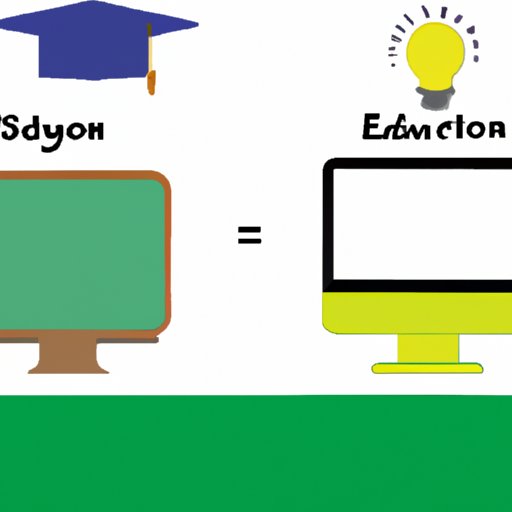Introduction
Technology has become an integral part of our lives, and its influence can be seen in almost every aspect of our day-to-day activities. In the educational sector, the use of technology has become increasingly important, with schools relying on digital tools to facilitate learning and teaching. But what percent of schools are actually using technology? This article will explore this question and examine the impact of technology on education.
A Survey of Schools: What Percent of Schools Use Technology?
According to a survey conducted by the US Department of Education, nearly 95% of all public K-12 schools have access to the internet. Furthermore, 97% of classrooms have access to computers, and 84% have access to tablets or other mobile devices. Additionally, 94% of teachers use computers for instruction, and 80% use tablets or other mobile devices. These findings indicate that technology is becoming increasingly prevalent in schools.
In addition, a 2018 report from the Center for Digital Education found that 99% of school districts across the United States have adopted some form of digital learning. This includes online courses, virtual reality simulations, and other interactive learning tools. The report also found that more than 90% of districts have implemented one-to-one programs, which provide each student with their own device to use during class.
How Technology is Transforming Education
The increasing use of technology in schools is transforming the way students learn and teachers teach. Digital tools such as online learning platforms, virtual reality simulations, and 3D printing are allowing students to explore topics in greater depth and engage with content in new and exciting ways. Furthermore, these tools are enabling teachers to create individualized learning plans for their students and track student progress in real time.
According to a study published in the International Journal of Research in Education and Science, “the use of technology in the classroom provides students with the opportunity to develop skills such as problem solving, decision making, critical thinking, and creativity.” The study also found that technology can help foster collaboration among students and encourage them to take ownership of their learning.

The Benefits of Technology for Students and Teachers
The use of technology in schools offers numerous benefits for both students and teachers. For students, technology can provide opportunities to engage with content in new and exciting ways, while also helping them to develop important skills such as problem-solving and critical thinking. Additionally, technology can help teachers create individualized learning plans for their students and track student progress in real time.
For teachers, technology can help make the teaching process more efficient. Digital tools such as online learning platforms and virtual reality simulations can help reduce the amount of time spent on planning and preparation, freeing up more time for meaningful interactions with students. Furthermore, technology can help teachers gather data on student performance and provide personalized feedback to students in a timely manner.

Exploring the Impact of Technology on Education
While the use of technology in schools can have many positive effects, there are also potential challenges that must be addressed. For example, some students may struggle to keep up with the pace of technological advances, while others may find it difficult to use the technology effectively. Additionally, inadequate training and limited resources can lead to a lack of confidence among teachers when using technology.
Furthermore, the implementation of technology can be costly, and some schools may not have the necessary funds to purchase the necessary equipment and software. Additionally, schools may need to invest in additional personnel to ensure that the technology is utilized effectively and maintained properly.
Conclusion
In conclusion, the use of technology in schools is becoming increasingly common, with nearly all public K-12 schools having access to the internet and most having implemented one-to-one programs. Technology has the potential to transform the way students learn and teachers teach, providing numerous benefits such as increased engagement and improved efficiency. However, there are also potential challenges that must be addressed, such as inadequate training and limited resources.
Overall, technology can be a powerful tool for improving the quality of education, but it is important that schools are equipped with the necessary resources and personnel to ensure that the technology is used effectively. With the right support, technology can be an invaluable asset for both students and teachers.
(Note: Is this article not meeting your expectations? Do you have knowledge or insights to share? Unlock new opportunities and expand your reach by joining our authors team. Click Registration to join us and share your expertise with our readers.)
